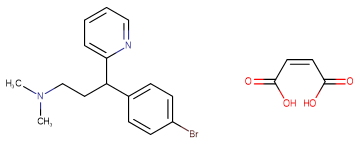
Brompheniramine hydrogen maleate
CAS No. 980-71-2
Brompheniramine hydrogen maleate( (±)-Brompheniramine )
Catalog No. M16888 CAS No. 980-71-2
Brompheniramine maleate is a histamine H1 receptors antagonist.
Purity : >98% (HPLC)
 COA
COA
 Datasheet
Datasheet
 HNMR
HNMR
 HPLC
HPLC
 MSDS
MSDS
 Handing Instructions
Handing Instructions
| Size | Price / USD | Stock | Quantity |
| 25MG | 45 | In Stock |


|
| 50MG | 55 | In Stock |


|
| 100MG | 76 | In Stock |


|
| 200MG | 137 | In Stock |


|
| 500MG | Get Quote | In Stock |


|
| 1G | Get Quote | In Stock |


|
Biological Information
-
Product NameBrompheniramine hydrogen maleate
-
NoteResearch use only, not for human use.
-
Brief DescriptionBrompheniramine maleate is a histamine H1 receptors antagonist.
-
DescriptionBrompheniramine maleate is a histamine H1 receptors antagonist. (In Vitro):Brompheniramine (0.1-100 μM) blocks hERG K+ channels expressed in CHO cells in a concentration-dependent manner with an IC50 of 0.90±0.14 μM, and reduced peak tail current amplitude measured at -60 mV (cells are depolarized for 2 s to +20 mV from a holding potential of -80 mV followed by a 3s repolarization back to -60 mV).Brompheniramine (1, 10 and 100 μM) significantly shortens the APD50 and depresses the plateau phase on the action potential in guinea pig papillary muscle, as well as slightly prolongs the APD90 in guinea pig papillary muscle at 10 and 100 μM.Brompheniramine (0.1-100 μM) inhibit the amplitude of the Ca2+ channel currents in rat ventricular myocytes by 14.1±1.1, 31.1±5.8, 38.0±3.8 and 90.2±3.7% at 0.1, 1, 10 and 100 μM, respectively.Brompheniramine blocks muscarinic cholinergic receptors in human chinese hamster ovary (CHO) cells.(In Vivo):Brompheniramine (0.3-3?μM; SC, single dosage) induces cutaneous analgesia in rats.
-
In VitroBrompheniramine (0.1-100 μM) blocks hERG K+ channels expressed in CHO cells in a concentration-dependent manner with an IC50 of 0.90±0.14 μM, and reduced peak tail current amplitude measured at -60 mV (cells are depolarized for 2 s to +20 mV from a holding potential of -80 mV followed by a 3s repolarization back to -60 mV).Brompheniramine (1, 10 and 100 μM) significantly shortens the APD50 and depresses the plateau phase on the action potential in guinea pig papillary muscle, as well as slightly prolongs the APD90 in guinea pig papillary muscle at 10 and 100 μM.Brompheniramine (0.1-100 μM) inhibit the amplitude of the Ca2+ channel currents in rat ventricular myocytes by 14.1±1.1, 31.1±5.8, 38.0±3.8 and 90.2±3.7% at 0.1, 1, 10 and 100 μM, respectively.Brompheniramine blocks muscarinic cholinergic receptors in human chinese hamster ovary (CHO) cells.
-
In VivoBrompheniramine (0.3-3?μM; SC, single dosage) induces cutaneous analgesia in rats. Animal Model:Male Sprague-Dawley rats Dosage:0.3, 0.6, 1.1, 1.5 and 3.0 ?μM Administration:SC, single dosage Result:Provoked cutaneous analgesia in a dose-dependent manner, with an EC50 value of 0.66 μM, and induced prolonged analgesic duration.
-
Synonyms(±)-Brompheniramine
-
PathwayEndocrinology/Hormones
-
Target5-HT Receptor
-
RecptorHT
-
Research AreaInflammation/Immunology
-
Indication——
Chemical Information
-
CAS Number980-71-2
-
Formula Weight435.31
-
Molecular FormulaC16H19BrN2·C4H4O4
-
Purity>98% (HPLC)
-
SolubilityEthanol: 18 mg/mL (41.34 mM); Water: 46 mg/mL warmed (105.67 mM); DMSO: 87 mg/mL (199.85 mM)
-
SMILESCN(C)CCC(C1=CC=C(C=C1)Br)C2=CC=CC=N2.C(=C\C(=O)O)\C(=O)O
-
Chemical Name——
Shipping & Storage Information
-
Storage(-20℃)
-
ShippingWith Ice Pack
-
Stability≥ 2 years
Reference
1.Tardioli S, et al. J Phys Chem B. 2012 Jun 21;116(24):7033-9.
molnova catalog



related products
-
Ro 60-0175
Ro 60-0175 is a potent, selective 5-HT2C receptor agonist.
-
MDL 100009
MDL 100009, the S-enantiomer of MDL 100151 and the opposite enantiomer of MDL 100907, is a selective antagonist of 5-HT2A.
-
N-Desmethylclozapine
N-Desmethylclozapine is an antagonist of serotonin (5-HT) receptor subtype 5-HT2C (IC50: 7.1 nM). It also is an antagonist at dopamine D4 receptors an agonist at δ-opioid receptors.



 Cart
Cart
 sales@molnova.com
sales@molnova.com


